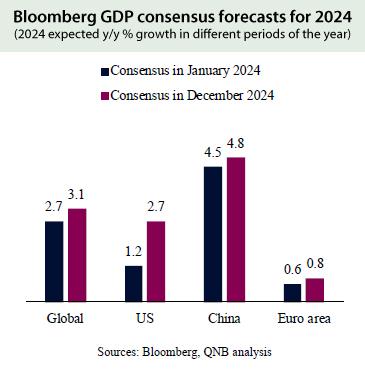
Positive Developments Overcame Uncertainty In 2024
Doha, Qatar: Early in the year, economic weakness across major advanced economies dominated the global macro agenda. A rapid slowdown in the US, disappointing growth in China and continuous stagnation in Europe provided a gloomy environment for 2024, with global growth expectations starting the year at 2.7%, only a touch above the 2.5% mark that commonly defines a global recession, QNB said in its economic commentary.
In H1 2024, both activity and inflation surprised to the upside globally, creating a temporary renewal of the“inflation scare” that contributed to spur significant uncertainty about the path and even the direction of policy rates. However, price pressures were related to lagging factors, such as housing costs. Despite this, labour markets eased gradually and remained resilient while inflation moderated. This triggered a change in sentiment and led to a turnaround of outlook later in the year.
Importantly, lower inflation justified the beginning of meaningful monetary policy easing cycles. The US Federal Reserve (Fed) cut policy rates by 100 basis points (bps) to 4.5% and the European Central Bank (ECB) cut by 100 bps to 3%.
As a result, the year ended up being defined by a more positive backdrop of moderate global growth of 3% combined with falling inflation across most advanced economies and significant monetary policy easing.
The estimated global growth of 3.1% for 2024 is a significant achievement, particularly given the low expectations early in the year. Importantly, the better than expected performance was broad-based, affecting all major economies, including the US, China and the Euro area.
In this article, we dive into three key drivers of 2024 that caused such upward revisions in global growth expectations.
First, US growth proved once again to be significantly more robust than previously anticipated. With growth estimated to close at 2.7% for the year, the US economy has maintained a strong level of growth, outpacing its long-term trend at 2.3%. Robust consumption, in particular, which represents around 70% of the country's GDP, helped to explain the US economic performance. US households are still benefiting from strong balance sheets, high levels of financials savings available for spending, and healthy income growth. As most US households re-financed their obligations at record low interest rates during the immediate post-pandemic period, they were mostly sheltered from the previous round of financial tightening, and are waiting to benefit from lower interest rates as the Fed moves forward with the easing cycle. Nevertheless, consumption remained robust, creating a strong baseline for US GDP growth.
Second, in China, after a difficult period of weak real estate and low consumer confidence, economic authorities launched a major package of policy stimulus, breaking with the previous cycle of limited, gradual and small support for economic activity. The package of new measures gained momentum after September, including with decisions such as the recapitalization of state banks, cuts in interest rates and reserve requirement ratios, more fiscal spending and support for real estate and capital markets. This triggered the beginning of a shift in investor sentiment and favoured more positive consumer behaviour.
While the initial effect has partially faded, it nevertheless created an uplift in the economy that creates a more stable basis for future growth.
Third, in the Euro area, while growth remained broadly stagnant, overall performance was still marginally superior to the gloomy expectations from early in the year. The energy crisis proved to have stabilized whereas fiscal policies remained relatively loose across several countries, often surpassing the Maastricht Treaty limit of 3 percent of GDP deficit.
This, alongside more tamed inflation and an improvement in real incomes, supported consumption and prevented a recession or a sharper slowdown.
All in all, the global economy proved once again to outperform pessimistic expectations from analysts, just like in 2023.
Positive conditions across most advanced economies with the gradual normalization of inflation, a monetary easing cycle and a stabilized Chinese economy favoured a moderate global growth of around 3.1 percent.

Legal Disclaimer:
MENAFN provides the
information “as is” without warranty of any kind. We do not accept
any responsibility or liability for the accuracy, content, images,
videos, licenses, completeness, legality, or reliability of the information
contained in this article. If you have any complaints or copyright
issues related to this article, kindly contact the provider above.


















Comments
No comment